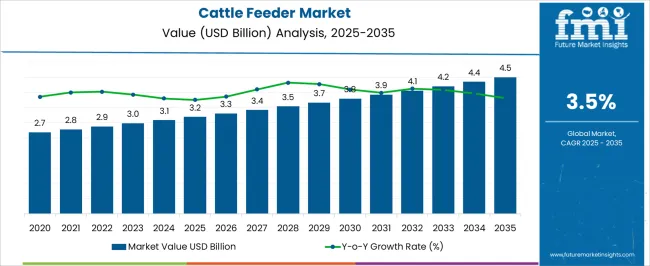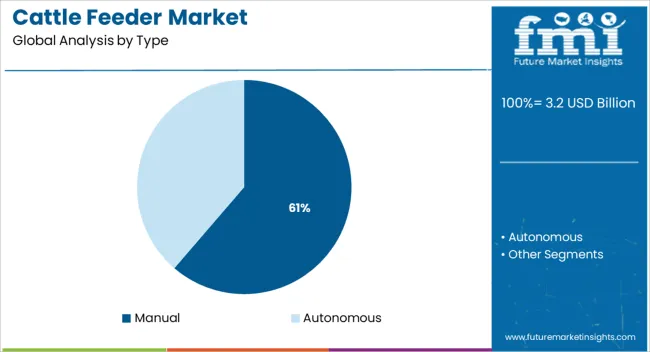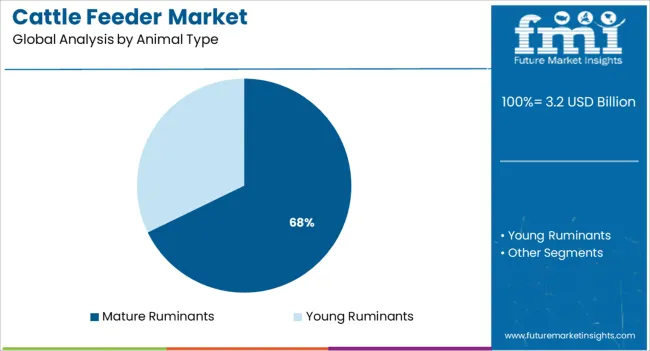The Cattle Feeder Market is estimated to be valued at USD 3.2 billion in 2025 and is projected to reach USD 4.5 billion by 2035, registering a compound annual growth rate (CAGR) of 3.5% over the forecast period.

| Metric | Value |
|---|---|
| Cattle Feeder Market Estimated Value in (2025 E) | USD 3.2 billion |
| Cattle Feeder Market Forecast Value in (2035 F) | USD 4.5 billion |
| Forecast CAGR (2025 to 2035) | 3.5% |
The Cattle Feeder market is witnessing notable growth due to increasing emphasis on livestock efficiency, feed optimization, and animal health management. The current market environment is shaped by growing investments in precision livestock farming and heightened awareness among cattle producers regarding feed cost management and nutrition strategies. Industry trade news and agricultural machinery updates have highlighted a rising demand for feeder systems that reduce feed wastage and support efficient distribution.
As farm sizes expand globally and demand for dairy and beef production continues to rise, the need for reliable and scalable feeding equipment is becoming more critical. Annual updates from leading manufacturers have pointed to increasing interest in adaptable and maintenance-friendly feeding systems that ensure consistent cattle performance.
Future growth is expected to be driven by technological innovations, rising labor costs in developed economies, and strong government support for animal welfare and farming mechanization These dynamics are expected to solidify long-term market opportunities in both mature and emerging agricultural regions.
The market is segmented by Type and Animal Type and region. By Type, the market is divided into Manual and Autonomous. In terms of Animal Type, the market is classified into Mature Ruminants and Young Ruminants. Regionally, the market is classified into North America, Latin America, Western Europe, Eastern Europe, Balkan & Baltic Countries, Russia & Belarus, Central Asia, East Asia, South Asia & Pacific, and the Middle East & Africa.

The manual type segment is anticipated to lead the Cattle Feeder market with a revenue share of 61.3% in 2025. Its dominant position is being supported by widespread adoption across small and medium-scale farms where mechanized systems remain cost-prohibitive. Manual feeders are being preferred for their simplicity, affordability, and ease of use, particularly in rural and developing areas where electricity access may be limited.
Trade journals and agricultural machinery bulletins have consistently shown that manual feeders are favored for their low maintenance and durable design, which aligns well with the resource constraints of smaller operations. Manufacturers have continued to improve material quality and ergonomics, enhancing user convenience while maintaining feed delivery efficiency.
Furthermore, the flexibility of manual systems allows farmers to manage feeding schedules based on herd behavior and specific nutritional requirements without relying on automated infrastructure These practical advantages have helped the segment retain a strong position in markets that value operational control, low investment cost, and straightforward maintenance.

The mature ruminants segment is projected to account for 67.8% of the Cattle Feeder market revenue share in 2025, securing its place as the leading animal type category. The growth of this segment is being driven by the rising global demand for beef and dairy products, which places increased emphasis on the productivity and health of mature cattle.
Agricultural news sources and veterinary practice reports have underscored the importance of tailored feeding systems that meet the nutritional needs of adult ruminants to maximize milk yield, weight gain, and overall output. Mature animals require precise feed management to avoid digestive disorders and maintain consistent performance, which is prompting cattle owners to adopt specialized feeding equipment.
Industry updates have indicated that feeding systems designed for mature ruminants are being enhanced with features that improve feed flow control and minimize waste This alignment with economic efficiency and herd performance has positioned the segment as a primary driver in the market’s revenue structure for 2025.
When compared to the 3.1% CAGR recorded between 2020 and 2025, the cattle feeder business is predicted to expand at a 3.5% CAGR between 2025 and 2035. The average growth of the market is expected to be approx 46% between 2025 and 2035.
| Market Statistics | Details |
|---|---|
| Market Share (2020) | USD 2,392.6 million |
| Market Share (2024) | USD 2,791.7 million |
| Market Share (2025) | USD 2,879.2 million |
Livestock production has become more industrialized as a result of the rising population and the need to meet the dietary and gustatory preferences of the populace in emerging nations. Cattle ranching has always been a backyard occupation in poor nations.
Short-term Growth (2025 to 2029): numerous factors, like the weather, seasonal production patterns, and price expectations, have an impact on marketing in the short term.
Medium-term Growth (2035 to 2035): economic factors assist the profits in a perfectly competitive industry in the coming years. It is expected to fluctuate until there are no net profits or losses in the sector.
Long-term Growth (2035 to 2035): long-term changes in the breeding herd and the calf crop are the main causes of the increased supply of cattle feeders.
The manual cattle feeder market segment is anticipated to expand quickly during the projected period of time. But among cow breeders, the acceptance of automatic cattle feeders is growing.
The product reduces labor and feeding time. Additionally, it uses just one hay bale, reducing feed both in terms of quantity and expense.
In addition to improving digestion and metabolism, automatic cattle feeders also save costs and require less work and manpower. Cattle breeders are constantly investing in the creation of automatic cattle grazing equipment that is affordable, highly functional, and long-lasting.
| Countries | Market Value (2025) |
|---|---|
| USA | USD 770.7 million |
| UK | USD 255.6 million |
| China | USD 258.52 million |
| Australia | USD 85.9 million |
| Germany | USD 531.2 million |
| Japan | USD 3.2 million |
| India | USD 108.7 million |
The US is expected to generate the greatest revenue due to rising beef product demand and increased implementation of cutting-edge automated equipment. In 2025, it holds the largest cattle feeder market share at 26.8%.
In the North American cattle feeder sector, there are many different operators who must deal with variable input and output costs. While most prices, such as feed and loan rates, are set by the key players, new market players of cattle feeders still have amazing opportunities.
On the international beef market, the United States accounts for a sizable portion of imported beef. The United States government is offering incentives for the import of cattle feeder equipment for various uses. This includes cattle ranching and cattle grazing, due to the lack of such equipment in the nation.
Statistical Look at the Market for Cattle Feeders
| Attributes | Statistics |
|---|---|
| UK Market Value 2025 | USD 255.6 million |
| UK Market Value 2035 | USD 369.5 million |
| UK Market Share (2025 to 2035) | 8.9% |
| UK Market CAGR (2025 to 2035) | 3.8% |
New items, better stocking practices, advancements in modeling, and other decision-support technologies, encourage the market share of cattle feeders. There is undoubtedly a greater understanding of systems that can handle more factors than previously realized and enable simpler judgments to enable better economic outcomes.
Cattle feeder investors are at ease with technology, but are wary of expenses and would need a more favorable economic outcome to return to the market. On the market for cattle feeder equipment, the European Union (EU) is predicted to experience moderate growth. The EU maintains a major proportion of the global soil pH tester market.
Strict environmental rules in the European Union are anticipated to limit the expansion of the cattle feeder sector. Also, it has an impact on the demand for agricultural and livestock equipment.
| Country | China |
|---|---|
| Market Share (2025) | 9% |
| CAGR (2025 to 2035) | 2.8% |
| Market Value (2035) | USD 340.9 million |
| Country | India |
|---|---|
| Market Share (2025) | 3.8% |
| CAGR (2025 to 2035) | 4.1% |
| Market Value (2035) | USD 162.6 million |
Due to accelerating economic expansion and urbanization, China continues to be the world's leading producer of feed and user of cattle feeders. The key factors driving the market are the growing concentration of domestic cattle feeders and government incentives for mechanization due to the expanding population.
The commercial cattle feeder industry in China is vital to the nation's development of the livestock industry and growing export markets for other nations. Due to the extensive impact of African Swine Fever, the Chinese feed business faced a brief blip in 2020. Nevertheless, over the anticipated term, the production of feed is anticipated to resume.
2020 saw the dedication of the feed mill owned by the National Dairy Development Board (NDDB), a national body in India, to Cargill Feed and Food India Pvt. Ltd.
In order to significantly contribute to the agricultural sector, NDDB created an initiative for small-scale dairy producers called the Dairy Entrepreneurship Development Scheme (DEDS). The business has also started a project in Gujarat, India to inform dairy farmers about cutting-edge, cutting-edge dairy farm management techniques.
The market in Japan is growing significantly, with a share of 3.9% and a worth of USD 3.2 million in 2025. It is anticipated that the industry would develop in the next few years as a result of the increased import of dairy and livestock goods.
Organic feed supplements are likely to grow quickly. Products like blood meal, feather meal, fish meal, flesh & bone meal, and glandular meal are among those found in the organic feed supplement market.
The feed additive is digested by the livestock as a source of protein and fat after being broken down in the stomach. These supplements, which are mostly used in livestock feed, provide quick and effective nutritional absorption in animals. As a result, cattle feeder manufacturers are focusing on feed additives for greater growth.

New product development and feed system innovations are important market drivers. Cattle feeder businesses are investing in Research and Development to create novel technologies that increase productivity while lowering costs.
System integration and automation continue to be crucial components for lowering costs and raising output for cattle feeders. The growth of feeders may be hampered by less expensive alternatives due to the market issue.
It is expected that these less expensive options cut into the revenues of key companies of cattle feeders. Additionally, less expensive options like plastic feeders are more likely to break and harm cows' digestive systems.
Cattle feeder startups are entering the market with new ideas and innovations. For instance, blockchain applications serve as a launchpad for a new player in the livestock feeder industry.
The business wants to create a transparent and effective method for tracking and regulating the livestock feeder market using blockchain technology. The US-based business has received USD 1.5 million in startup capital from backers such as Boost VC, Compound VC, and GV.
The business intends to use blockchain to build a decentralized market where feedlots may use smart contracts to acquire and sell cattle feeders. The platform also enables feedlots to trace the cattle's lineage and the conditions of their upbringing. In the first quarter of 2020, the company intends to begin a pilot program in the United States.
Recent Developments
The global cattle feeder market is estimated to be valued at USD 3.2 billion in 2025.
The market size for the cattle feeder market is projected to reach USD 4.5 billion by 2035.
The cattle feeder market is expected to grow at a 3.5% CAGR between 2025 and 2035.
The key product types in cattle feeder market are manual and autonomous.
In terms of animal type, mature ruminants segment to command 67.8% share in the cattle feeder market in 2025.






Our Research Products

The "Full Research Suite" delivers actionable market intel, deep dives on markets or technologies, so clients act faster, cut risk, and unlock growth.

The Leaderboard benchmarks and ranks top vendors, classifying them as Established Leaders, Leading Challengers, or Disruptors & Challengers.

Locates where complements amplify value and substitutes erode it, forecasting net impact by horizon

We deliver granular, decision-grade intel: market sizing, 5-year forecasts, pricing, adoption, usage, revenue, and operational KPIs—plus competitor tracking, regulation, and value chains—across 60 countries broadly.

Spot the shifts before they hit your P&L. We track inflection points, adoption curves, pricing moves, and ecosystem plays to show where demand is heading, why it is changing, and what to do next across high-growth markets and disruptive tech

Real-time reads of user behavior. We track shifting priorities, perceptions of today’s and next-gen services, and provider experience, then pace how fast tech moves from trial to adoption, blending buyer, consumer, and channel inputs with social signals (#WhySwitch, #UX).

Partner with our analyst team to build a custom report designed around your business priorities. From analysing market trends to assessing competitors or crafting bespoke datasets, we tailor insights to your needs.
Supplier Intelligence
Discovery & Profiling
Capacity & Footprint
Performance & Risk
Compliance & Governance
Commercial Readiness
Who Supplies Whom
Scorecards & Shortlists
Playbooks & Docs
Category Intelligence
Definition & Scope
Demand & Use Cases
Cost Drivers
Market Structure
Supply Chain Map
Trade & Policy
Operating Norms
Deliverables
Buyer Intelligence
Account Basics
Spend & Scope
Procurement Model
Vendor Requirements
Terms & Policies
Entry Strategy
Pain Points & Triggers
Outputs
Pricing Analysis
Benchmarks
Trends
Should-Cost
Indexation
Landed Cost
Commercial Terms
Deliverables
Brand Analysis
Positioning & Value Prop
Share & Presence
Customer Evidence
Go-to-Market
Digital & Reputation
Compliance & Trust
KPIs & Gaps
Outputs
Full Research Suite comprises of:
Market outlook & trends analysis
Interviews & case studies
Strategic recommendations
Vendor profiles & capabilities analysis
5-year forecasts
8 regions and 60+ country-level data splits
Market segment data splits
12 months of continuous data updates
DELIVERED AS:
PDF EXCEL ONLINE
Cattle Feeder Panels Market Size and Share Forecast Outlook 2025 to 2035
Cattle Mineral Feeder Market Size and Share Forecast Outlook 2025 to 2035
Cattle and Sheep Disease Diagnostic Kits Market Size and Share Forecast Outlook 2025 to 2035
Cattle Feed Market Analysis - Size, Share, and Forecast Outlook 2025 to 2035
Cattle Squeeze Market Size and Share Forecast Outlook 2025 to 2035
Cattle Head Catch Market Size and Share Forecast Outlook 2025 to 2035
Cattle Grooming Chute Market Size and Share Forecast Outlook 2025 to 2035
Cattle Handling Systems Market Size and Share Forecast Outlook 2025 to 2035
Cattle Blower Market Size and Share Forecast Outlook 2025 to 2035
Cattle Management Software Market Size and Share Forecast Outlook 2025 to 2035
Cattle Supplies Market Analysis & Forecast for 2025 to 2035
Cattle Nutrition Market Analysis by Cattle Type, Nutrition Type, Application, Life Stage Through 2025 to 2035
Smart Cattle Market
Dairy Cattle Feed Market
Automatic Cattle Waterer Market – Trends & Growth Forecast 2025 to 2035
Feeder Container Market Size and Share Forecast Outlook 2025 to 2035
Hog Feeder Market Size and Share Forecast Outlook 2025 to 2035
Belt Feeders Market Size and Share Forecast Outlook 2025 to 2035
Weft Feeder Market Trend Analysis Based on Type, Operation, Application, and Region 2025 to 2035
Pump Feeders Market Growth - Trends & Forecast 2025 to 2035

Thank you!
You will receive an email from our Business Development Manager. Please be sure to check your SPAM/JUNK folder too.
Chat With
MaRIA